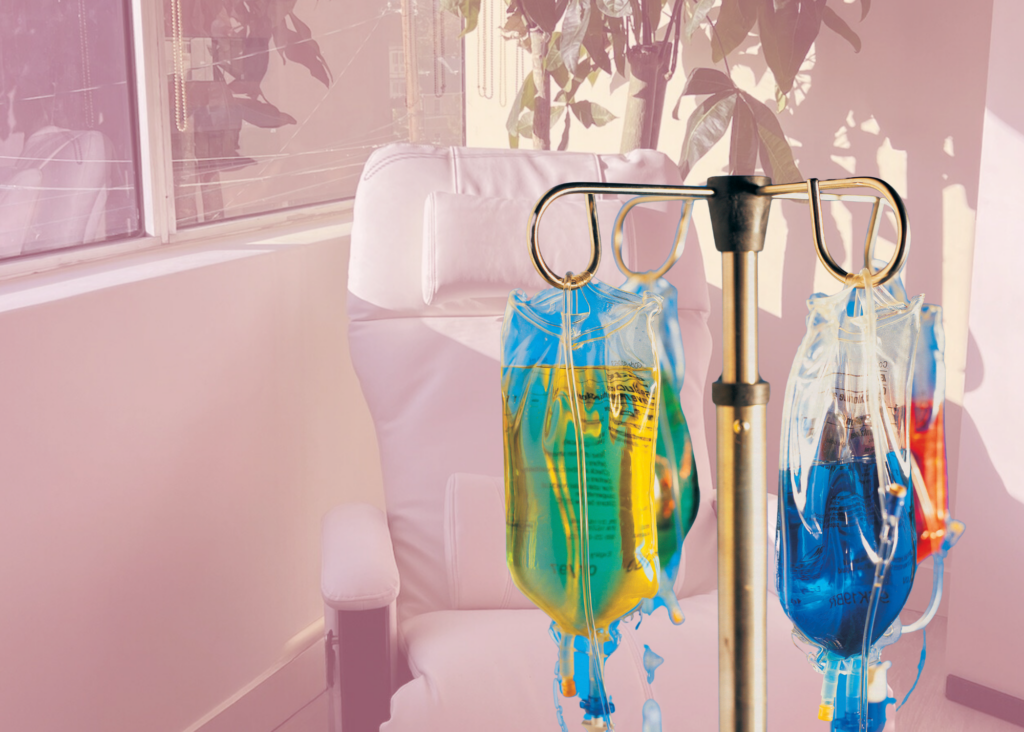IV vitamin therapy is a health treatment in which nutrients, such as vitamins and minerals, are delivered directly into the bloodstream through an IV drip. This method bypasses your digestive system, allowing your body to absorb these nutrients more quickly and effectively. It’s designed for people who want to boost their wellness or support their immune system. Athletes, busy professionals, and people recovering from illness often seek IV vitamin treatment to feel more energized and balanced. This is also beneficial for individuals who struggle to absorb nutrients from food or supplements.
The IV Vitamin Therapy Procedure Explained
Pre-Treatment
Before starting IV therapy services, clinics perform a quick but important check of your health. This typically involves reviewing your medical history, checking for allergies, and verifying your current medications. Blood pressure, pulse, and oxygen levels are often measured to ensure your body can safely handle the infusion. Some clinics may also ask about recent illnesses or hospital visits. If you have certain medical conditions, you may need a doctor’s approval. The idea is to personalize the treatment and avoid complications. These early steps create a more tailored experience for every person.
Insertion and Infusion
A trained professional will insert a small IV needle, usually into a vein in your arm. You’ll be seated comfortably, and the nutrients begin to flow slowly into your bloodstream. Sessions for drip IV therapy usually last between 30 and 60 minutes. You might feel a cooling sensation or mild pressure, but most people describe the process as painless and relaxing. You’re free to read, scroll your phone, or rest while the drip is administered. The practitioner monitors your response, making sure the rate and dosage are safe throughout the session.

Common Ingredients
Delivering nutrients directly into the bloodstream bypasses the digestive system, allowing for quicker absorption and more efficient utilization. Each formula varies, but most IV nutrition blends include essentials like:
- Electrolytes – Magnesium, potassium, and sodium form the core of most IV therapy formulations due to their essential role in fluid regulation, muscle function, and nerve signaling. Sodium is vital for maintaining hydration and blood pressure, while potassium supports muscle contraction, including the heartbeat, and stabilizes nerve transmission. Magnesium is often included to reduce cramping, support muscle relaxation, and promote a calmer nervous system response, particularly during periods of stress. These minerals quickly correct imbalances caused by illness, heat exposure, or intense physical activity. Unlike oral hydration, IV delivery ensures that these electrolytes reach the bloodstream promptly, making them particularly effective in preventing dehydration and enhancing recovery from fatigue or gastrointestinal distress. They also serve as a base for more targeted nutrients to act efficiently.
- B-Vitamins – These are frequently included in IV therapies due to their integral role in energy metabolism and neurological stability. The B-complex includes eight distinct vitamins—such as B1 (thiamine), B2 (riboflavin), B6 (pyridoxine), and B12 (cobalamin)—each of which performs unique tasks related to converting food into usable energy, producing neurotransmitters, and maintaining nerve health. In IV form, B vitamins can provide an immediate sense of revitalization, especially for individuals experiencing low energy, brain fog, or chronic stress. Vitamin B12 is often singled out for its mood-lifting and metabolism-boosting properties, while B6 contributes to cognitive function and hormone regulation. For individuals with digestive conditions or nutrient malabsorption, IV delivery of these vitamins provides a direct and impactful alternative to oral supplementation.
- Amino Acids – These building blocks of protein are essential for tissue repair, neurotransmitter production, and optimal metabolic function. Amino acids like L-glutamine, L-carnitine, arginine, and tryptophan are commonly used to support muscle recovery after physical exertion, enhance mental clarity, and promote better sleep. Some amino acids also help regulate hormone levels and boost immune function, making them a key component in comprehensive wellness formulas.
- Zinc & Taurine – Both are often paired in IV therapy to enhance immune readiness, cellular defense, and metabolic function. Zinc is a trace mineral crucial for immune system efficiency, wound healing, and antioxidant activity. It supports white blood cell performance and helps shorten the duration of illnesses like the common cold. In IV form, zinc is quickly bioavailable, essential during the early stages of infection or during immune challenges. Taurine, on the other hand, is a sulfur-containing amino acid involved in cardiovascular health, neurological development, and bile salt formation. It also exhibits antioxidant properties and supports energy production by aiding mitochondrial function.
Understanding these common ingredients can help you make informed decisions about your infusion options and better appreciate the science behind the drip.
Post-Treatment
After your session, the needle is removed, and a small bandage is placed on the site. Most people feel a noticeable boost in energy shortly after. It’s essential to drink water and eat a light meal to support the effects of vitamin hydration therapy. You may feel refreshed within minutes, while others experience benefits gradually over a few hours. Minor redness or bruising at the insertion point may occur, but it typically fades quickly without requiring additional care.
Key Benefits of IV Drips
Rapid Rehydration and Electrolyte Rebalancing
One of the most immediate effects of IV vitamin drips is the ability to quickly restore fluid levels in the body. When fluids are delivered through a vein, they bypass the digestive tract and enter circulation directly, making the process much faster than drinking water or sports drinks. This method is especially useful after physical exertion, when dehydration can occur quickly. As emphasized previously, the benefits of IV fluids also extend to correcting imbalances of electrolytes, helping the body return to normal function with greater efficiency.
Vitamin C IV Drip Benefits
Vitamin C plays a vital role in supporting immune health and aiding collagen production, both of which are critical for wellness and skin vitality. Receiving a dose intravenously ensures higher absorption than taking it orally, making it more effective for individuals who need a quick boost. Many individuals turn to vitamin C IV drip benefits during cold and flu season or when preparing for travel. Beyond immune support, it’s often sought for its contribution to brighter skin and reduced inflammation.
Risks, Side Effects, and Safety Considerations
Mild Reactions:
Most people tolerate IV vitamin therapy very well, but there are some minor effects that can occur during or shortly after treatment. Here are some common mild effects associated with vitamin drip side effects:
- Warmth in the Body – Some people experience a mild warming sensation as the fluid enters the bloodstream. This is usually due to magnesium or B vitamins, which can temporarily cause the blood vessels to widen slightly. The feeling is typically harmless and fades within a few minutes.
- Bruising at the Insertion Site – It’s not uncommon to notice slight discoloration around where the needle was inserted. This happens when a small amount of blood leaks into the surrounding tissue, and is more likely if you have sensitive skin. Bruising generally disappears within a few days.
- Unusual Taste in the Mouth – Certain nutrients, especially B vitamins and zinc, can create a metallic or vitamin-like taste during the drip. This taste might appear suddenly and vanish shortly after the session ends. Drinking water often helps reduce or eliminate this sensation.
They’re a sign that the nutrients are moving through your system, and in most cases, they resolve on their own quickly and without the need for follow-up care.
Who Should Avoid or Get Medical Clearance Before Treatment
Individuals with congestive heart failure, kidney dysfunction, or chronic lung conditions may be at risk of complications. Individuals undergoing chemotherapy or taking certain medications should consult their healthcare provider first. Pregnant or breastfeeding individuals should also consult with their OB-GYN before considering this type of therapy. A responsible clinic will always ask detailed health questions before proceeding with IV vitamin drips, and you should never hesitate to share your full medical history. Transparency ensures the safest experience possible for both patients and providers.

Importance of Aseptic Technique
Cleanliness is essential to the safe delivery of IV nutrients. Aseptic technique refers to the practice of preventing infection through the use of sterilized tools, hand hygiene, and single-use materials. Only licensed healthcare providers should administer IV therapy to minimize risks, such as contamination or incorrect dosing. Clinics that specialize in IV detox procedures often follow strict protocols to ensure patient safety. It’s also essential that staff are trained in handling adverse reactions, so if anything unusual occurs, they know how to respond. Never compromise on professionalism when choosing where to receive treatment.
Customization, Cost, and Scheduling Options
Choosing the Right Drip
Selecting the best IV drip for your needs depends on your health priorities and lifestyle. Some individuals seek immune support during flu season, while others look for a detoxifying boost after periods of stress or overindulgence. Recovery-based drips are often rich in electrolytes and amino acids to help the body bounce back after strenuous activity or illness. Clinics typically offer several formulas, each designed to achieve a different health goal. The ingredients in these drips can be adjusted depending on your nutritional needs, making immune-boosting IV therapy highly customizable. While a one-time session can be effective for short-term relief, ongoing results often require a more consistent approach. Many clinics offer packages that include multiple treatments over several weeks or months. These bundled programs are ideal for individuals seeking to achieve long-term wellness goals. Regular treatments may also facilitate gradual improvements in nutrient absorption and hydration status. With scheduled sessions, it becomes easier to track changes over time and adjust formulations as needed. Frequent users of IV vitamin therapy often experience more sustained benefits than those who use it sporadically.
IV Vitamin Therapy Cost
The cost of IV therapy can vary widely depending on the type of drip, location, and provider. Prices for single sessions often reflect the quality of ingredients, the clinic’s setting, and the training level of staff. Some facilities offer basic hydration drips at a lower cost, while advanced formulations with high-dose nutrients are priced higher. Packages and memberships can help reduce per-session expenses and may include perks like priority scheduling. When evaluating the value of IV therapy services, it’s essential to consider the short-term benefits and the potential for long-term health improvements.
Seasonal Adjustments and Add-Ons
Your body’s nutritional needs may shift with the seasons, making it helpful to adjust IV drips accordingly. During colder months, immune-focused drips with zinc and vitamin C may be more appropriate, while summer treatments might emphasize hydration and cooling minerals. Some clinics allow clients to add extra nutrients or boosters to their base formula for an additional fee. These add-ons can be tailored to specific health challenges or lifestyle needs, offering more personalized support. Choosing a flexible approach to IV vitamin treatment helps you respond to changing demands throughout the year.
Making the Most of Your IV Vitamin Therapy
Preparing for Your Appointment
Getting the most from your IV session starts with proper preparation. It’s helpful to drink water before arriving, as being well-hydrated can make it easier for the clinician to access your vein. Eating a light meal ahead of time is also recommended, since some nutrients in the drip may cause a mild reaction if administered on an empty stomach. Arriving calm and relaxed helps your body respond more favorably to the session. When your system is already nourished and balanced, it can distribute the contents of vitamin infusion therapy without delay.
Lifestyle Habits That Maximize Infusion Results
After receiving an IV drip, your body continues to absorb and utilize the nutrients over the next 24 to 48 hours. To amplify the results, it’s wise to avoid excessive alcohol, processed foods, and high-stress activities right after your appointment. Prioritizing rest, gentle movement such as walking or stretching, and consuming nutrient-dense meals will help prolong the positive effects. Maintaining a consistent wellness routine further supports your system’s ability to retain the benefits.

Understanding Realistic Outcomes
It’s important to have clear expectations before starting treatment. IV therapy can support your energy and immunity, but it is not a substitute for medical care or a healthy lifestyle. Some people feel noticeable changes within hours, while others may experience subtle improvements over time. Reactions vary based on factors like nutrient deficiencies and sleep quality. Drip hydration works best when integrated with other wellness practices rather than viewed as a miracle cure.
The value of IV therapy depends greatly on how and where it’s delivered. Taking time to evaluate the clinic’s credibility, the qualifications of the staff, and the cleanliness of the facility is crucial. It’s equally important to consider your health status and discuss the treatment with your physician if you have any underlying concerns. By doing so, you reduce the likelihood of complications and increase the chances of a successful experience. Intravenous vitamin C, B-complex, and other popular ingredients can play a beneficial role when used responsibly, as part of a comprehensive approach to balance and prevention.